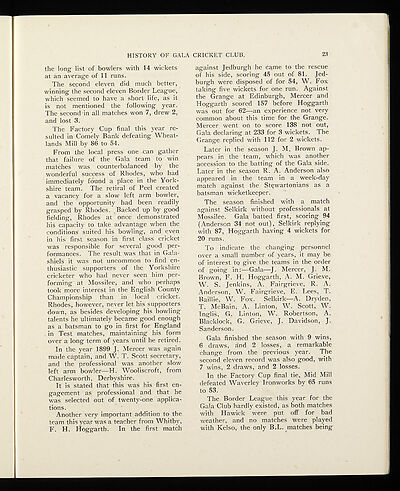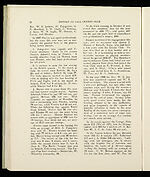Download files
Complete book:
Individual page:
Thumbnail gallery: Grid view | List view

HISTORY OF GALA CRICKET CLUB. 23
the long list of bowlers with 14 wickets
at an average of 11 runs.
The second eleven did much better,
winning the second eleven Border League,
which seemed to have a short life, as it
is not mentioned the following year.
The second in all matches won 7, drew 2,
and lost 3.
The Factory Cup final this year re-
sulted in Comely Bank defeating Wheat-
lands Mill by 86 to 54.
From the local press one can gather
that failure of the Gala team to win
matches was counterbalanced by the
wonderful success of Rhodes, who had
immediately found a place in the York-
shire team. The retiral of Peel created
a vacancy for a slow left arm bowler,
and the opportunity had been readily
grasped by Rhodes. Backed up by good
fielding, Rhodes at once demonstrated
his capacity to take advantage when the
conditions suited his bowling, and even
in his first season in first class cricket
was responsible for several good per-
formances. The result was that in Gala-
shiels it was not uncommon to find en-
thusiastic supporters of the Yorkshire
cricketer who had never seen him per-
forming at Mossilee, and who perhaps
took more interest in the English County
Championship than in local cricket.
Rhodes, however, never let his supporters
down, as besides developing his bowling
talents he ultimately became good enough
as a batsman to go in first for England
in Test matches, maintaining his form
over a long term of years until he retired.
In the year
1899
J. Mercer was again
made captain, and W. T. Scott secretary,
and the professional was another slow
left arm bowler—H. Wooliscroft, from
Charlesworth, Derbyshire.
It is stated that this was his first en-
gagement as. professional and that he
was selected out of twenty-one applica-
tions.
Another very important addition to the
team this year was a teacher from Whitby,
F. H. Hoggarth
.
In the. first match
against Jedburgh he came to the rescue
of his side
,
scoring 45 out of 81. Jed-
burgh were disposed of for 54, W. Fox
taking five wickets for one run. Against
the Grange at Edinburgh, Mercer and
Hoggarth scored 157 before Hoggarth
was out for 62—an experience not very
common about this time for the Grange.
Mercer went on to score 138 not out,
Gala declaring at 233 for 3 wickets. The
Grange replied with 112 for 2 wickets.
Later in the season J. M. Brown ap-
pears in the team, which was another
accession to the batting of the Gala side.
Later in the season R. A. Anderson also
appeared in the team in a week-day
match against the Stewartonians as a
batsman wicketkeeper. +
The season finished with a match
against Selkirk without professionals at
Mossilee. Gala batted first, scoring 94
(Anderson 34 not out), Selkirk replying
with 87
,
Hoggarth having 4 wickets for
20 runs.
To indicate the changing personnel
over a small number of years, it may be
of interest to give the teams in the order
of going in:—Gala
-j.
Mercer, J. M.
Brown, F. H. Hoggarth, A. M. Grieve,
W. S. Jenkins, A. Fairgrieve, R. A.
Anderson, W. Fair�Zrieve, E. Lees, T.
Baillie, W. Fox. Selkirk—A. Dryden,
T. McBain, A. Linton, W. Scott, W.
Inglis, G. Linton, W. Robertson, A.
Blacklock, G. Grieve, J. Davidson, J.
Sanderson.
Gala finished the season with 9 wins,
6 draws, and 2 losses, a remarkable
change from the previous year. The
second eleven record was also good, with
7 wins, 2 draws, and 2 losses.
In the Factory Cup final tie, Mid Mill
defeated Waverley Ironworks by 65 runs
to 53.
The Border League this year for the
Gala Club hardly existed, as both matches
with Hawick were put off for bad
weather
,
and no matches were played
with Kelso, the only B.L. matches being
the long list of bowlers with 14 wickets
at an average of 11 runs.
The second eleven did much better,
winning the second eleven Border League,
which seemed to have a short life, as it
is not mentioned the following year.
The second in all matches won 7, drew 2,
and lost 3.
The Factory Cup final this year re-
sulted in Comely Bank defeating Wheat-
lands Mill by 86 to 54.
From the local press one can gather
that failure of the Gala team to win
matches was counterbalanced by the
wonderful success of Rhodes, who had
immediately found a place in the York-
shire team. The retiral of Peel created
a vacancy for a slow left arm bowler,
and the opportunity had been readily
grasped by Rhodes. Backed up by good
fielding, Rhodes at once demonstrated
his capacity to take advantage when the
conditions suited his bowling, and even
in his first season in first class cricket
was responsible for several good per-
formances. The result was that in Gala-
shiels it was not uncommon to find en-
thusiastic supporters of the Yorkshire
cricketer who had never seen him per-
forming at Mossilee, and who perhaps
took more interest in the English County
Championship than in local cricket.
Rhodes, however, never let his supporters
down, as besides developing his bowling
talents he ultimately became good enough
as a batsman to go in first for England
in Test matches, maintaining his form
over a long term of years until he retired.
In the year
1899
J. Mercer was again
made captain, and W. T. Scott secretary,
and the professional was another slow
left arm bowler—H. Wooliscroft, from
Charlesworth, Derbyshire.
It is stated that this was his first en-
gagement as. professional and that he
was selected out of twenty-one applica-
tions.
Another very important addition to the
team this year was a teacher from Whitby,
F. H. Hoggarth
.
In the. first match
against Jedburgh he came to the rescue
of his side
,
scoring 45 out of 81. Jed-
burgh were disposed of for 54, W. Fox
taking five wickets for one run. Against
the Grange at Edinburgh, Mercer and
Hoggarth scored 157 before Hoggarth
was out for 62—an experience not very
common about this time for the Grange.
Mercer went on to score 138 not out,
Gala declaring at 233 for 3 wickets. The
Grange replied with 112 for 2 wickets.
Later in the season J. M. Brown ap-
pears in the team, which was another
accession to the batting of the Gala side.
Later in the season R. A. Anderson also
appeared in the team in a week-day
match against the Stewartonians as a
batsman wicketkeeper. +
The season finished with a match
against Selkirk without professionals at
Mossilee. Gala batted first, scoring 94
(Anderson 34 not out), Selkirk replying
with 87
,
Hoggarth having 4 wickets for
20 runs.
To indicate the changing personnel
over a small number of years, it may be
of interest to give the teams in the order
of going in:—Gala
-j.
Mercer, J. M.
Brown, F. H. Hoggarth, A. M. Grieve,
W. S. Jenkins, A. Fairgrieve, R. A.
Anderson, W. Fair�Zrieve, E. Lees, T.
Baillie, W. Fox. Selkirk—A. Dryden,
T. McBain, A. Linton, W. Scott, W.
Inglis, G. Linton, W. Robertson, A.
Blacklock, G. Grieve, J. Davidson, J.
Sanderson.
Gala finished the season with 9 wins,
6 draws, and 2 losses, a remarkable
change from the previous year. The
second eleven record was also good, with
7 wins, 2 draws, and 2 losses.
In the Factory Cup final tie, Mid Mill
defeated Waverley Ironworks by 65 runs
to 53.
The Border League this year for the
Gala Club hardly existed, as both matches
with Hawick were put off for bad
weather
,
and no matches were played
with Kelso, the only B.L. matches being
Set display mode to:
![]() Universal Viewer |
Universal Viewer | ![]() Mirador |
Large image | Transcription
Mirador |
Large image | Transcription
Images and transcriptions on this page, including medium image downloads, may be used under the Creative Commons Attribution 4.0 International Licence unless otherwise stated. ![]()
| Sports publications > History of Gala Cricket Club, 1853 to 1939 > (25) |
|---|
| Permanent URL | https://digital.nls.uk/228784123 |
|---|
| Description | More than 230 sports publications from the National Library of Scotland's collections. Featured sports include football, rugby, golf, shinty, athletics, bowls, cricket and hockey. Among the material from the late 19th and early 20th centuries are match programmes, club histories, and handbooks. From the late 20th century are promotional materials to encourage greater diversity in sport. Most items cover sports activities in Scotland. There are also publications relating to the Olympics and international matches. |
|---|---|
| Additional NLS resources: |
|

